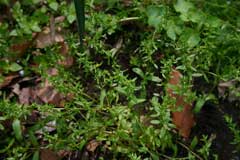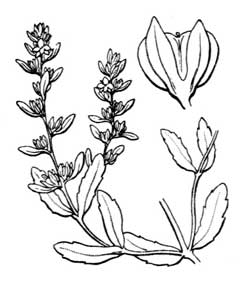 |
|
commons.wikimedia.org/wiki/User:SB_Johnny |
 |
| etching by Hippolyte Coste (1858-1924), Flore descriptive et illustrée de la France, de la Corse et des contrées limitrophes, published from 1900 to 1906 by Paul Klincksieck |
Translate this page:
Summary
Physical Characteristics

 Veronica peregrina is a ANNUAL/BIENNIAL growing to 0.2 m (0ft 8in). It is in flower from April to July. The species is hermaphrodite (has both male and female organs). The plant is self-fertile.
Veronica peregrina is a ANNUAL/BIENNIAL growing to 0.2 m (0ft 8in). It is in flower from April to July. The species is hermaphrodite (has both male and female organs). The plant is self-fertile.
Suitable for: light (sandy), medium (loamy) and heavy (clay) soils and prefers well-drained soil. Suitable pH: mildly acid, neutral and basic (mildly alkaline) soils. It cannot grow in the shade. It prefers moist or wet soil.
UK Hardiness Map
US Hardiness Map
Synonyms
Plant Habitats
Bog Garden;
Edible Uses
References More on Edible Uses
Medicinal Uses
Plants For A Future can not take any responsibility for any adverse effects from the use of plants. Always seek advice from a professional before using a plant medicinally.
Emmenagogue Haemostatic Stings
The whole plant is emmenagogue and haemostatic[147]. It promotes the knitting together of broken bones[147]. A decoction is used in the treatment of dysmenorrhoea, fractures, haemoptysis and traumatic injuries[218].
References More on Medicinal Uses
The Bookshop: Edible Plant Books
Our Latest books on Perennial Plants For Food Forests and Permaculture Gardens in paperback or digital formats.

Edible Tropical Plants
Food Forest Plants for Hotter Conditions: 250+ Plants For Tropical Food Forests & Permaculture Gardens.
More

Edible Temperate Plants
Plants for Your Food Forest: 500 Plants for Temperate Food Forests & Permaculture Gardens.
More

More Books
PFAF have eight books available in paperback and digital formats. Browse the shop for more information.
Shop Now
Other Uses
References More on Other Uses
Cultivation details
Easily grown in a moderately fertile moisture retentive well drained soil[200]. Prefers cool summers[200].
References Carbon Farming Information and Carbon Sequestration Information
Temperature Converter
Type a value in the Celsius field to convert the value to Fahrenheit:
Fahrenheit:
The PFAF Bookshop
Plants For A Future have a number of books available in paperback and digital form. Book titles include Edible Plants, Edible Perennials, Edible Trees,Edible Shrubs, Woodland Gardening, and Temperate Food Forest Plants. Our new book is Food Forest Plants For Hotter Conditions (Tropical and Sub-Tropical).
Shop Now
Plant Propagation
Seed - sow spring or late summer in situ.
Other Names
If available other names are mentioned here
Native Range
NORTHERN AMERICA: Canada (Yukon, Québec, Nova Scotia, Ontario (south), Prince Edward Island, New Brunswick, Saskatchewan, Alberta, Manitoba, British Columbia), United States (Alaska, Indiana, Maine, Massachusetts, Michigan, New Hampshire, New Jersey, New York, Ohio, Pennsylvania, Rhode Island, Vermont, West Virginia, Connecticut, Iowa, Kansas, Minnesota, Missouri, Nebraska, North Dakota, South Dakota, Illinois, Oklahoma, Wisconsin, Colorado, Idaho, Montana, Oregon, Washington, Wyoming, Alabama, Arkansas, Delaware, Florida, Georgia, Kentucky, Louisiana, Maryland, South Carolina (http://cricket.biol.sc.edu/herb/V/2852.jpg), Virginia, Mississippi, Tennessee, New Mexico, Texas, Arizona, California, Nevada, Utah), Mexico (Baja, Sonora) SOUTHERN AMERICA: Hispaniola, Bahamas, Jamaica, United States (Puerto Rico), Guatemala, Panama, Brazil (south), Bolivia, Colombia, Ecuador (Azuay, Bolívar, Cañar, Chimborazo, Cotopaxi, Imbabura, Loja, Napo, Pichincha, Tungurahua), Peru (Cajamarca, Lambayeque), Argentina (Córdoba, Mendoza, Buenos Aires, Catamarca, Chaco, Chubut, Corrientes, Entre Ríos, Jujuy, La Pampa, La Rioja, Misiones, Neuquén, Río Negro, Salta, Santa Cruz, Santa Fe, Tucumán, Tierra del Fuego, Ciudad Autónoma de Buenos Aires), Chile (Biobío, Coquimbo, Maule, Libertador General Bernardo O Higgins, Región Metropolitana de Santiago, Valparaíso, Aisén del General Carlos Ibañez del Campo, La Araucanía, Los Lagos), Uruguay
Weed Potential
Right plant wrong place. We are currently updating this section.
Please note that a plant may be invasive in one area but may not in your area so it's worth checking.
Conservation Status
IUCN Red List of Threatened Plants Status :

Growth: S = slow M = medium F = fast. Soil: L = light (sandy) M = medium H = heavy (clay). pH: A = acid N = neutral B = basic (alkaline). Shade: F = full shade S = semi-shade N = no shade. Moisture: D = dry M = Moist We = wet Wa = water.
Now available:
Food Forest Plants for Mediterranean Conditions
350+ Perennial Plants For Mediterranean and Drier Food Forests and Permaculture Gardens.
[Paperback and eBook]
This is the third in Plants For A Future's series of plant guides for food forests tailored to
specific climate zones. Following volumes on temperate and tropical ecosystems, this book focuses
on species suited to Mediterranean conditions—regions with hot, dry summers and cool, wet winters,
often facing the added challenge of climate change.
Read More
Expert comment
Author
L.
Botanical References
158
Links / References
For a list of references used on this page please go here
Readers comment
| Add a comment |
|
If you have important information about this plant that may help other users please add a comment or link below. Only comments or links that are felt to be directly relevant to a plant will be included. If you think a comment/link or information contained on this page is inaccurate or misleading we would welcome your feedback at [email protected]. If you have questions about a plant please use the Forum on this website as we do not have the resources to answer questions ourselves.
* Please note: the comments by website users are not necessarily those held by PFAF and may give misleading or inaccurate information.
To leave a comment please Register or login here All comments need to be approved so will not appear immediately.
|
Subject : Veronica peregrina
|
|
|
|